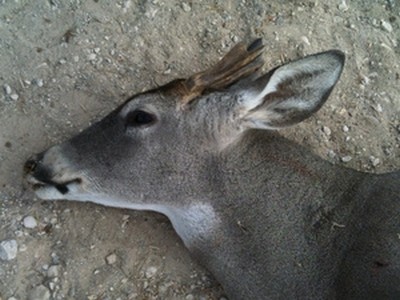White-tailed deer hunters know that bucks in Texas usually experience antler growth during the spring and summer and then shed their antlers during mid to late winter each year. This typically ends up being sometime in January, February, or possibly even March. Although the bulk of 2010 was an outstanding year for the habitat that produced an abundance of forbs and browse, some ranches discovered that their bucks had gone through early antler shedding. And by early I mean these bucks lost their antlers in late summer. What? Yes, antler shedding during August and September.
Yes, you read that correctly. Landowners and biologists on several properties in South Texas first noticed otherwise healthy bucks shedding antlers during late summer and early autumn, often when the antlers were still in velvet. Because some of these bucks were photographed regularly at feed sites, they could be readily tracked as autumn progressed. Several of these bucks began growing antlers again, resulting in small antlers whose velvet was then shed.
This story actually begins in 2007 when David Kitner, manager of the Duval County Ranch, first noticed an unusual number of culls and contacted Texas Parks and Wildlife Department (TPWD). Another guide from the same area also reported this problem. The deer in question had only the burr present or antlers only a few inches long. They were primarily middle aged or mature. It was obvious the antlers were not broken, just severely stunted. Three years ago researchers concluded these antlers probably resulted from a genetic abnormality in a small percentage of deer.

Fast-forward to 2010. Ranch owners were observing this phenomenon on helicopter surveys and in trail camera photos from Premont to Cotulla, and other reports came in from as far as Medina County. These bucks were sometimes harvested as culls on the logical assumption that the abnormal antlers were due to a genetic defect. Later, as word got out that the lack of antlers may have occurred because of early antler shedding, many ranches let these bucks walk. If antlers shed early because of environmental conditions, these bucks may very well grow normal antlers next year.
The number of bucks affected by this malady is small, perhaps a dozen on large properties with hundreds of whitetail bucks. However, understanding the cause and consequences of early antler shedding is imperative because bucks with antlers are important for recreational and commercial hunting. Another question deer managers still have is why were only a few bucks so drastically affected while other bucks on the same properties produced record B&C scores over 200 inches, both in 2007 and 2010?
The annual antler cycle normally begins with antler growth during summer, which is brought to an end when testosterone concentrations in the blood increase during September. Increased testosterone causes antler velvet to dry and hard antler to develop. Testosterone continues to increase through the rut, and then begins to decrease through late winter, causing antlers to be cast during late February through March. Although testosterone influences the antler growth cycle, there are other hormones, vitamins, and metabolites that may influence antler development, hardening, and casting. The antler cycle is physiologically complex and there is still much to learn.
Back to the early antler shedding situation. Why were antlers being shed during late summer in South Texas? One clue could be that both 2007 and 2010 had wet summers following a dry year. The working hypothesis right now is that a specific plant, mold, or fungus eaten during wet summers is causing antlers to drop. The ingested material could disrupt hormonal balance in the deer or cause a condition similar to ergot poisoning in livestock. The Duval County Ranch sent several deer to local vet Glen Wilkinson, who has seen this phenomenon before over the years. Initial testing indicates below average bone density, but no other abnormalities. Testosterone assays of blood samples from one buck indicate normal concentrations, although the buck was harvested several months after shedding.
Before antlers are cast this spring, affected landowners and biologists from the CKWRI and TPWD will capture some of the affected bucks on different ranches, tag them, and determine if they grow normal antlers next year. The outcome will provide guidance for biologists making harvest decisions if early shedding bucks are seen in future years.
In the meantime, it would be valuable to know the extent to which this abnormal pattern of antler shedding occurs. If you noted otherwise healthy bucks shedding antlers during late summer or autumn, please contact either Daniel Kunz at djkunz@sbcglobal.net or David Hewitt at david.hewitt@tamuk.edu. Let them know the county in which you observed such abnormal deer, and an approximate number of bucks affected. In the meantime, enjoy the rest of the whitetail hunting season.